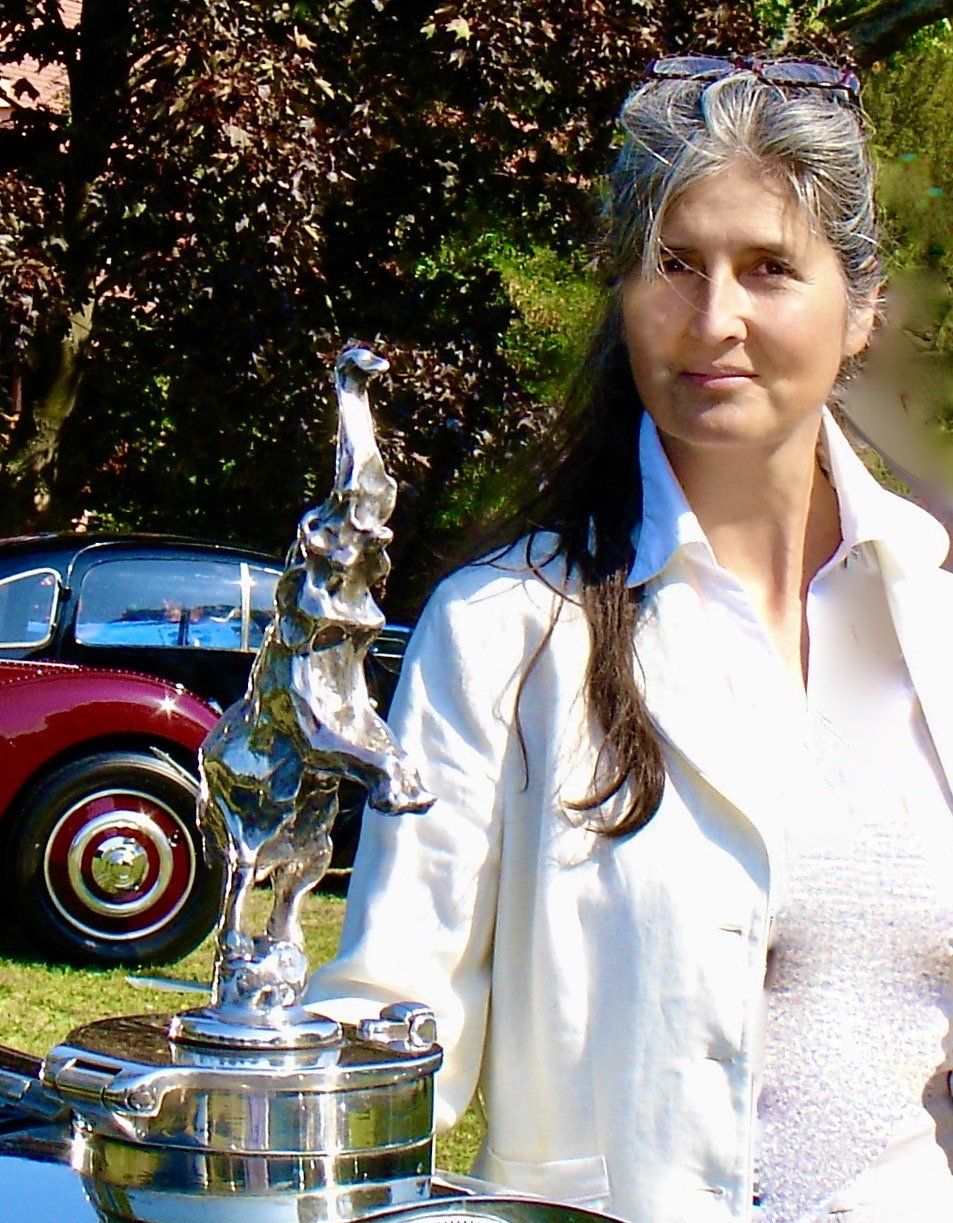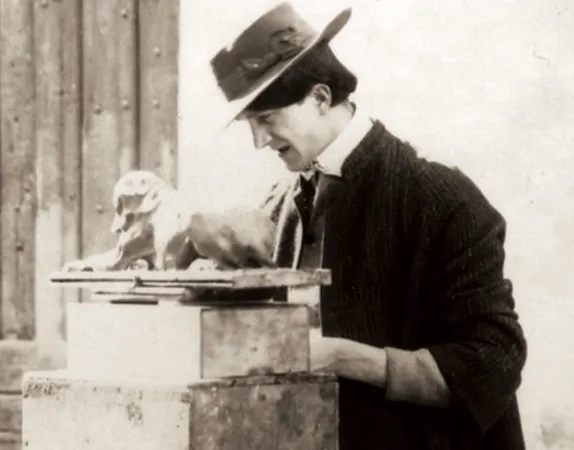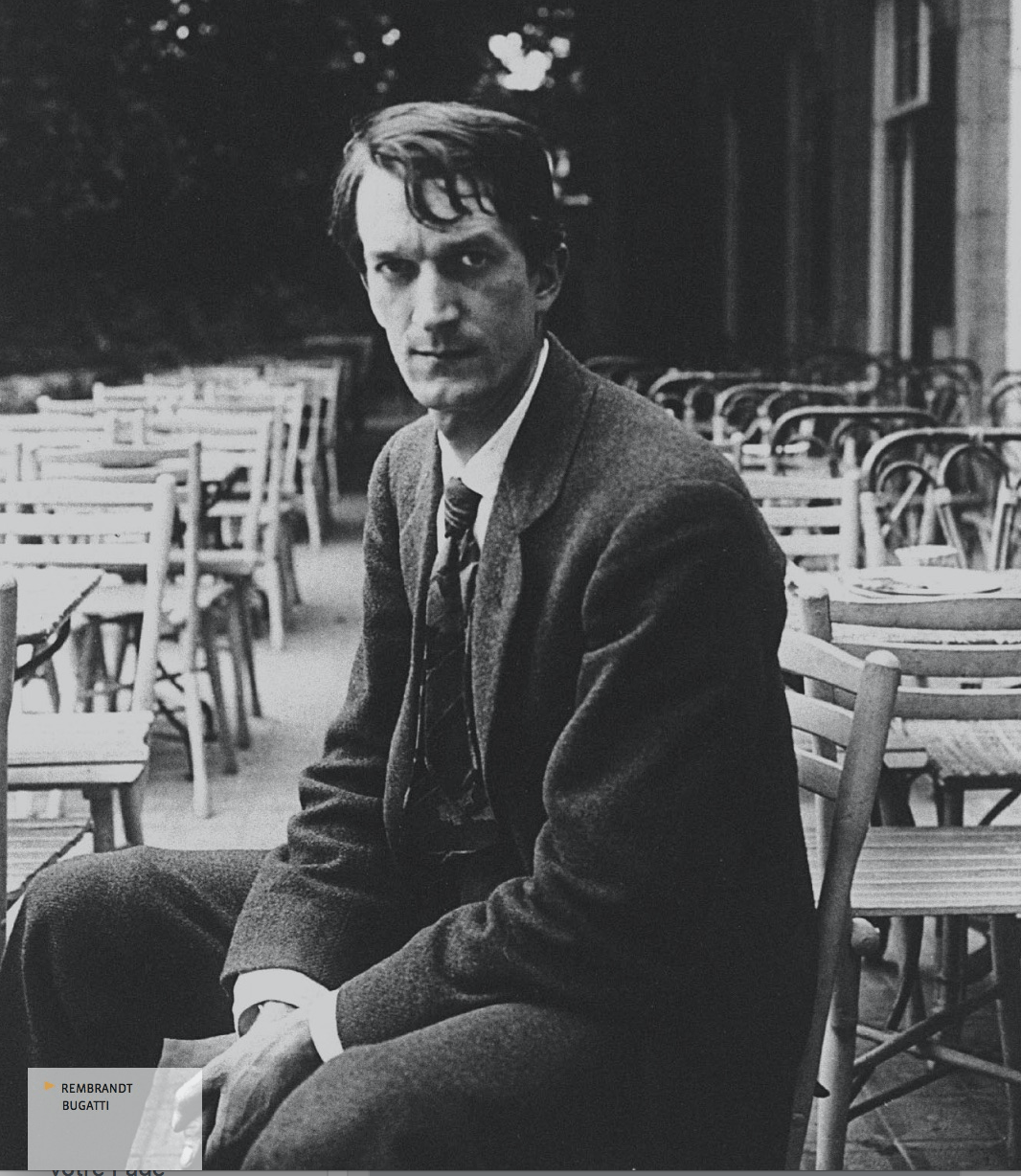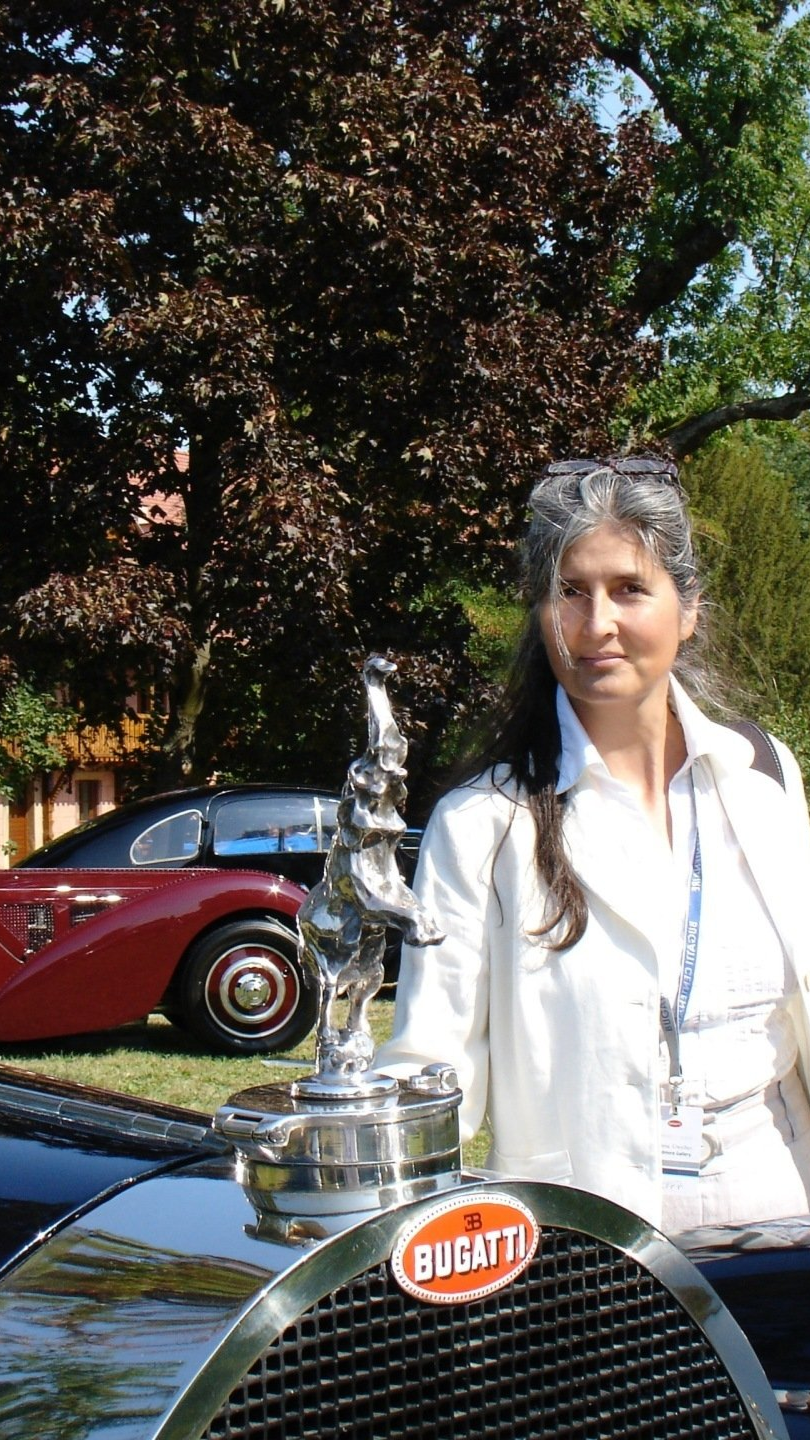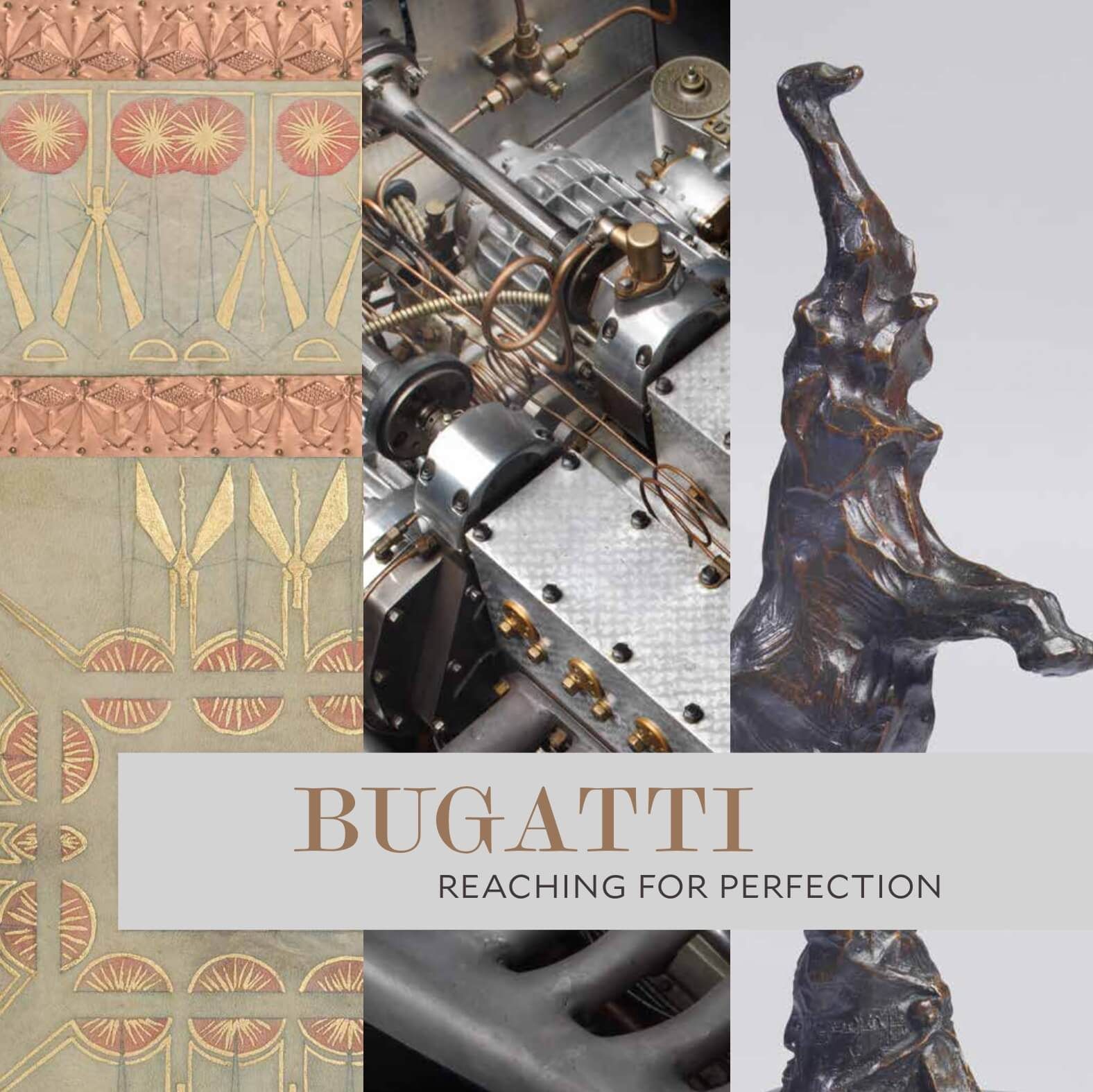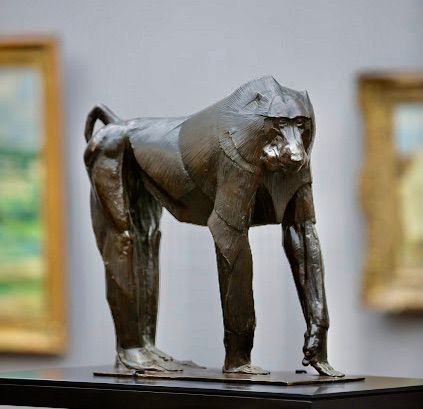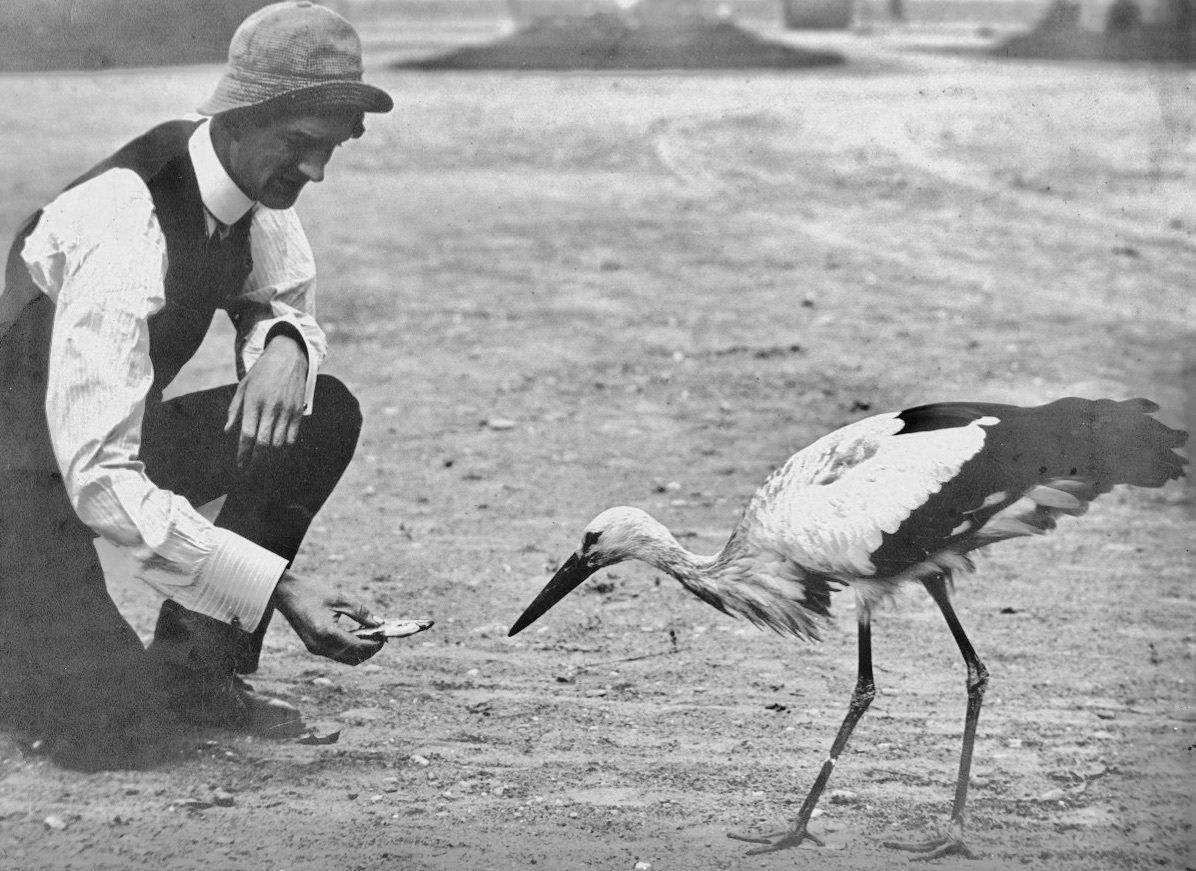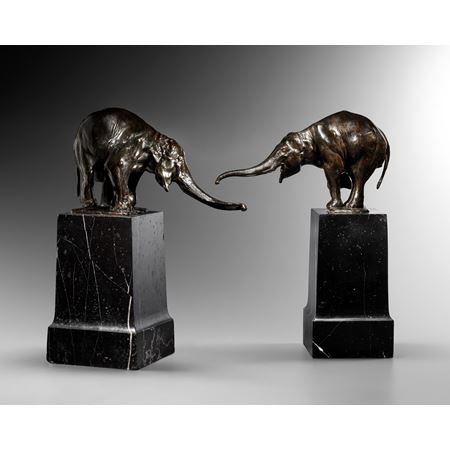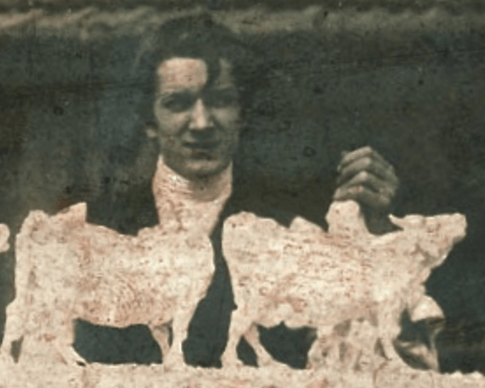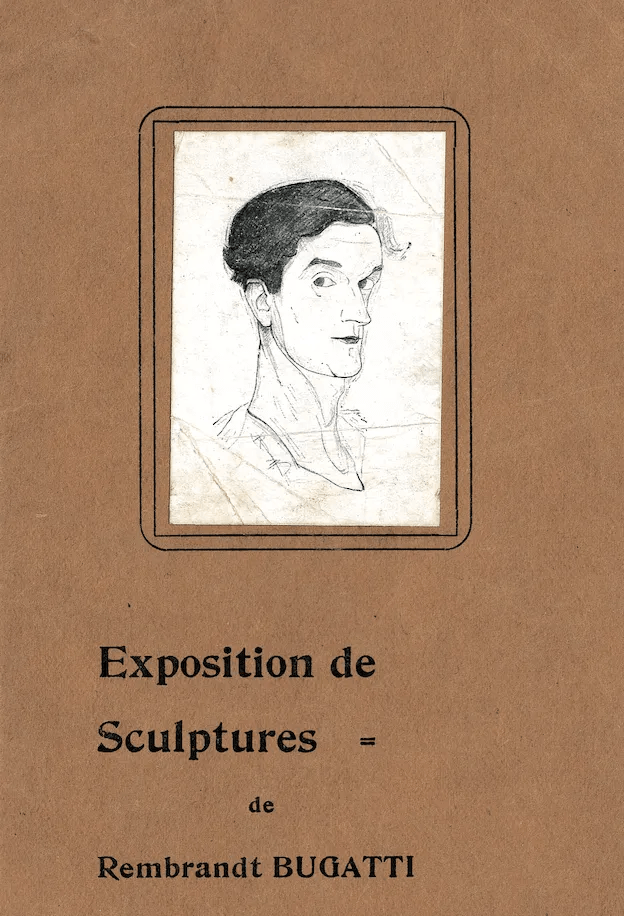fromanger@rembrandtbugatti.info
Répertoire monographique
V.Fromanger 2016
The present monographic repertoire shows us the opulence of shapes, areas and perspectives of Rembrandt Bugatti’s art, conceived with a kind of certainty and freedom that even the greatest challenges, in view of his mooching-around models, mastered without an effort: a photographic memory, a quasi one-to-one transfer from eye to hand; not an animal sculptor, rather a born sculptor per se; an absolute talent in sculpture, a man, whom every vehicle seemed to be fitting, in order to capture life in all of its forms and feelings; a portraitist of humans and animals, for whom the fauna from every continent, in the end, opened a world of patterns and structures, rhythms and means of behaviour, which, in order to tap the fullest potential, would have brought other talent to their limits.
And, the monographic repertoire shows us even more: a young man – an obvious lone wolf and still a family-oriented man, a man with humour and fickleness having the greatest self-confidence and the most abysmal doubts. Even in terms of how to place him nationally – highly elusive, half of the continent – how modern! – all in one single gestalt: a tall, young Italian in conspicuous clothes, whom one, for this reason, would surely call „Americano“, who speaks the language of France and lives in Flanders, while his brother builds cars in Alsace. The dachshund that accompanies him is a German? After all, he has the German name »Wurst« (sausage).
Keeping the memory alive and the magnificent rediscovery of Rembrandt Bugatti for a wide audience is, as it was often the case in the past, first the work of individuals; people who fight for their convictions over years and decades beyond all fashions, who restlessly and laboriously save works, sources and documents, trace descendants, record traditions and exhibit art. Véronique Fromanger and the people close to her have done all of this.
A monographic repertoire is the highest acclaim of a life’s work – and, within itself, the same thing: a mission of titanic proportion.
Rembrandt Bugatti – and all of us – owe much to the author of the book at hand. „I hope and believe that I will succeed in creating a life’s work that no contemporary or previous animal sculptor had ever created“, wrote Bugatti. The monographic repertoire at hand proves that his hope came true. The serious and profound manner in which Rembrandt captured the wealth of the world in his sculptures make him one of the most unique artists in the history of sculpture.
Texte de Philipp Demandt, Berlin 2014
SYNOPSIS:
I. Qui sont les "pères" de Rembrandt Bugatti ?
- Giovanni Segantini - Carlo Bugatti - Paolo Troubetzkoy - Giuseppe Grandi et Medardo Rosso - La Galerie Grubicy et Bice Bugatti -
Who were Rembrandt Bugatti’s "fathers"?
- Giovanni Segantini - Carlo Bugatti - Paolo Troubetzkoy - Giuseppe Grandi and Medardo Rosso - The Grubicy gallery and Bice Bugatti-Segantini - All’amico Borgatti
II. 1884-1902: Milan et l'époque pré-futuriste
- Milan - " Ritorno dal pascolo " - Bugatti et la photographie - Bugatti créateur de l'instant à multiples dimensions - Albino Palazzolo - Ettore Bugatti
1884-1902: Milan and the pre-Futurist period.
- Milan - Ritorno dal Pascolo - Bugatti and photography - Bugatti : creator of the single moment in multiple dimensions - Albino Palazzolo - Ettore Bugatti
III. Paris et le Jardin des Plantes
- Carlo et Rembrandt Bugatti s'installent à Paris - La Ménagerie nationale du Jardin des Plantes et le Museum d'Histoire naturelle - La renaissance des sciences naturelles - Bugatti et les animaux sauvages - Les panthères, ses compagnons d'existence
Paris and the Jardin des Plantes
- Carlo and Rembrandt Bugatti settle in Paris - The Ménagerie nationale at the Jardin des Plantes and the Museum d'Histoire naturelle - The renaissance of the natural sciences - Bugatti and wild animals - Panthers, his companions in life and work
IV. Bugatti : un modeleur et un mouleur
- Bugatti : " J’espère et je crois réussir à faire une oeuvre unique au monde " authentique, universelle, intemporelle. - Le modelage à main libre et le moulage en plâtre - La gypsothèque Rembrandt Bugatti et le fonds d'atelier
Bugatti, a modeller and mould-maker
- Bugatti:
“
I hope and indeed believe I am successful in creating a body of work like no other animalier sculptor before or since...” - Marcel Horteloup and Diane's letters - Free hand modelling and plaster casting - The Rembrandt Bugatti gypsotheque and studio collection: Ebé Bugatti
V. Paris, chef de file du marché de l'art moderne
- Paris haut lieu de la création - L'ivresse du progrès et les marchands d'art - La sculpture : un art difficile à vendre, la ruine des marchands d'art
Paris, a leading light in the modern art trade
- Paris, capital of the creative arts - Art dealers and the euphoria of progress - Sculpture, an art form difficult to sell and the ruin of the art dealers
VI. A.A. Hébrard et Cie (1902-c.1934)
- une alliance entre l'Art et l'Industrie - 1904 : La première exposition : " Rembrandt Bugatti " à la Galerie Hébrard rue Royale à Paris - Bugatti à 20 ans - Le contrat d'édition - René Dubois - La fonderie A.A. Hébrard : Albino Palazzolo et les ouvriers - Hébrard et Rodin - A.A.Hébrard ou la reproduction authentique d'une oeuvre d'art - L’Édition Originale A.A.Hébrard (1902-c.1934)
A.A. Hébrard & Cie (1902-c.1934)
- An alliance between art and industry - 1904: the first Rembrandt Bugatti exhibition at the Hébrard Gallery - Bugatti at twenty years old - Le contrat d'édition-the artist licensing agreement - René Dubois, Rembrandt Bugatti's adoptive father - The A.-A Hébrard foundry: Albino Palazzolo and the workers - Hébrard and Rodin - The A.-A.Hébrard foundry: Albino Palazzolo and the foundry workers - Hébrard and Rodin - A.A. Hébrard or the authentic reproduction of an oeuvre d'art
VII. 1903 à 1908 : de Paris à Anvers, tel un oiseau migrateur
- Bugatti à Paris, témoin de son temps. - Les chevaux de trait et le "Montreur d'ours" - Bugatti et les animaux familiers - Bugatti et les animaux sauvages des Jardins zoologiques - Bugatti au zoo d'Anvers, son atelier de plein air - Bugatti analyse le lien animal, la communication. - Les cervidés : une fougueuse spontanéïté, une vitalité absolue de la matière ou le dynamisme plastique. - Bugatti et Marcello Valsuani - Bugatti aime les oiseaux : les pélicans, les flamants, les cigognes. - Bugatti se compare aux marabouts - A Montparnasse et rue Duméril Bugatti explore le thème du nu - " La sculpture, c'est comme une femme " Kathleen Bruce , Dejanice Bugatti et Barbara Bugatti - Le " Colosse nu assis " ou l'ami White à l'exposition Grubicy - Bugatti, un éthologue plasticien. - " Mes Antilopes " - Les autres mammifères, de puissantes architectures vivantes. - Le commerce des animaux sauvages, les éléphants d'Asie et les jaguars.
1903-1908 From Paris to Antwerp: a migratory bird on the wing
- Rembrandt Bugatti in Paris, a witness of his age - Draught horses and bear tamers: Le marché aux chevaux (R.M.n43) Dix minutes de repos (R.M.n139) and Montreur d'ours (R.M.n140) - Bugatti and domestic animals: cats and dogs - Bugatti and the wild animals of the zoological gardens Loup et Louve, l'un contre l'autre (R.M.n103) - Bugatti at the Antwerp Zoo, his open-air studio - Bugatti analyses the animal bond and communication - The Cervidae : a fiery spontaneity , the absolute vitality of matter or plastic dynamism: Cerf chinois et ses quatre biches (R.M.n153) - Bugatti and Valsuani: wild goats and mountain sheep - Bugatti and his passion for birds: pelicans, flamingos, storks and marabouts - Bugatti compares himself to a Marabou Stork - In Montparnasse and the rue Duméril, Bugatti explored the theme of the nude - “ Sculpture is like a woman.” Kathleen Bruce , Dejanice Bugatti and Barbara Bugatti - Paris, 1907: L'Ami White at the Alberto Grubicy exhibition - Rembrandt Bugatti: ethologist, plasticien and "a narrator of animal psychology" - 1908: Mes Antilopes (R.M.n216) - The other mammals : powerful living architecture - Hippopotame baîllant (R.M.n138) , Panthère grognant (R.M.n208)- The wild animal trade , elephants and jaguars - The Jaguars - The Elephants
VIII. 1909 à 1911 : Bugatti consacre tout son temps à préparer les grandes expositions.
- Installation de l'usine Ettore Bugatti à Molsheim en Alsace - Rembrandt Bugatti, désormais seul face à son destin. - Bugatti élargit son champ de vision, son regard se transforme. - 1910 : l’ exposition à Anvers et les pièces uniques. - Bugatti se passionne pour les grands mammifères ruminants. - Les animaux sauvages sont devenus ses amis de tous les jours. - Le Rhinocéros indien et le Bison d'Amérique : déjà en voie de disparition au début du XXè siècle. - En 1911 Hébrard présente une collection de 100 sculptures. - A Paris l'Avant-Garde européenne est en pleine effervescence. - Bugatti souffre de l'éloignement familial et de son manque d'argent. - Le "Colosse nu debout" ou " le surhomme " mis à nu
1909-1911 : Bugatti's time is entirely devoted to preparing for important exhibitions
- Ettore Bugatti 's factory is established in Molsheim , Alsace - Rembrandt Bugatti now faces his destiny alone - As Bugatti broadens his visual horizons, his sculptural vision is transformed: Grand Fourmilier (R.M.n237) - 1910: the Antwerp Exhibition and the pièce unique: Groupe de cinq vieux chevaux (R.M.n246) - Rembrandt Bugatti and his fascination for large ruminant mammals: Petit Buffle "anoa" (R.M.n261) - The wild animals become familiar friends - The Indian Rhinoceros (Rhinoceros unicornis) and the American Bison (Bison bison) : already endangered species by the turn of the twentieth century - Hébrard's 1911 exhibition of one hundred sculptures: the fruit of eight years of creativity - In Paris, the European avant-garde worked in a creative ferment - Isolated from his family and with dwindling funds, Bugatti suffers much hardship - Colosse, lutteur Olympique or the “übermensch” stripped bare
IX . 1912-1914 : L’esprit de novation interrompu par la Grande Guerre.
- La "Marchande de pommes" et le portrait mondain. - L’esprit de novation côtoie la Belle Epoque. - Bugatti expose chez Alberto Grubicy et les Futuristes chez Berhneim-Jeune. - Bugatti a su capter le language des animaux, il a croisé leurs regards pendant quinze ans. - Bugatti retrouve les grands rapaces au zoo d'Anvers. - Pour saisir l'animal Bugatti a une vision synthétique tout à la fois précise et complexe. - Les Condors vus par Claude Koening et Rungwe Kingdon-Pangolin Editions - Les tirages en bronze réservés à Ettore Bugatti - Fin 1913 : Bugatti écrit à un ami : ".....maintenant ça commence à aller....." - Le "Tigre Royal" du Bengale et le "Tigre de Sibérie" (ou Tigre de l'Amour)
1912 - 1916: The prevailing spirit of innovation is interrupted by the Great War
- Marchande de pommes (R.M.n283) and portraits of the high society - The spirit of innovation meets the Belle Époque: a time of contrasts - Bugatti exhibits with Alberto Grubicy and the futurists with Bernheim-Jeune - Bugatti is adept at capturing the language of animals; for fifteen years he met their gaze - Bugatti retrouve les grands rapaces au zoo d'Anvers:les serpentaires,les vautours, les condors - To capture a likeness of the animal before him, Bugatti's approach is at once a precise and complex work of synthesis - The Condors editioned by Claude Koenig and Rungwe Kingdon (Pangolin Editions) - The bronze casts made exclusively for Ettore Bugatti - As the year 1913 drew to a close, Bugatti wrote to a friend: "Now things are beginning to go well” - The Royal Bengal Tiger and The Siberian Tiger
X. Rembrandt Bugatti meurt à Paris le 8 janvier 1916.
- Août 1914 , Anvers : le désastre de la Grande Guerre. Bugatti devient brancardier. - Décembre 1914 : Bugatti part à Milan rejoindre sa famille; avec l'aide de Palazzolo, il expose chez Grubicy. - Mai 1915 , Milan : Rembrandt Bugatti se porte volontaire, il est déja tuberculeux. - Décembre 1915 : Bugatti revient à Paris. Il se suicide le 8 janvier 1916 - 1916 : le témoignage de son ami milanais, l'architecte Giulio Ulisse Arata. - Pour son frère, Ettore Bugatti va reprendre le flambeau. - Adrien-Aurélien Hébrard va rouvrir la fonderie avec Albino Palazzolo.
The events leading to Rembrandt Bugatti's death on 8 January 1916
-
Antwerp, August 1914 : the tragedy of the Great War. Bugatti became a stretcher-bearer - December 1914 : Bugatti left for Milan to rejoin his family. With Palazzolo' help he exhibited with Alberto Grubicy - May 1915 : Rembrandt Bugatti volunteered for war duties despite already suffering from tuberculosis - December 1915 : Bugatti returned to Paris. His suicide followed on 8 January 1916 - 1916 : an account written by Bugatti's friend, the Milanese architect Giulio Ulisse Arata - Ettore Bugatti takes up the torch for his brother - Adrien-Aurélien Hébrard reopens the foundry with Albino Palazzolo's help - The A.-A.Hébrard cahiers - A.-A.Hébrard original editions (1904-c.1934)
ÉPILOGUE : POUR LE REGARD TOUT EST CONTEMPORAIN. AUTEUR: VERONIQUE FROMANGER
EPILOGUE : "TO THE EYE ALL IS CONTEMPORARY" Towards a new vision: the centennial celebration of Rembrandt Bugatti's life
The present monographic repertoire shows us the opulence of shapes, areas and perspectives of Rembrandt Bugatti’s art, conceived with a kind of certainty and freedom that even the greatest challenges, in view of his mooching-around models, mastered without an effort: a photographic memory, a quasi one-to-one transfer from eye to hand; not an animal sculptor, rather a born sculptor per se; an absolute talent in sculpture, a man, whom every vehicle seemed to be fitting, in order to capture life in all of its forms and feelings; a portraitist of humans and animals, for whom the fauna from every continent, in the end, opened a world of patterns and structures, rhythms and means of behaviour, which, in order to tap the fullest potential, would have brought other talent to their limits.
And, the monographic repertoire shows us even more: a young man – an obvious lone wolf and still a family-oriented man, a man with humour and fickleness having the greatest self-confidence and the most abysmal doubts. Even in terms of how to place him nationally – highly elusive, half of the continent – how modern! – all in one single gestalt: a tall, young Italian in conspicuous clothes, whom one, for this reason, would surely call „Americano“, who speaks the language of France and lives in Flanders, while his brother builds cars in Alsace. The dachshund that accompanies him is a German? After all, he has the German name »Wurst« (sausage).
Keeping the memory alive and the magnificent rediscovery of Rembrandt Bugatti for a wide audience is, as it was often the case in the past, first the work of individuals; people who fight for their convictions over years and decades beyond all fashions, who restlessly and laboriously save works, sources and documents, trace descendants, record traditions and exhibit art. Véronique Fromanger and the people close to her have done all of this.
A monographic repertoire is the highest acclaim of a life’s work – and, within itself, the same thing: a mission of titanic proportion.
Rembrandt Bugatti – and all of us – owe much to the author of the book at hand. „I hope and believe that I will succeed in creating a life’s work that no contemporary or previous animal sculptor had ever created“, wrote Bugatti. The monographic repertoire at hand proves that his hope came true. The serious and profound manner in which Rembrandt captured the wealth of the world in his sculptures make him one of the most unique artists in the history of sculpture.
Texte de Philipp Demandt, Berlin 2014
SYNOPSIS:
I. Qui sont les "pères" de Rembrandt Bugatti ?
- Giovanni Segantini - Carlo Bugatti - Paolo Troubetzkoy - Giuseppe Grandi et Medardo Rosso - La Galerie Grubicy et Bice Bugatti -
Who were Rembrandt Bugatti’s "fathers"?
- Giovanni Segantini - Carlo Bugatti - Paolo Troubetzkoy - Giuseppe Grandi and Medardo Rosso - The Grubicy gallery and Bice Bugatti-Segantini - All’amico Borgatti
II. 1884-1902: Milan et l'époque pré-futuriste
- Milan - " Ritorno dal pascolo " - Bugatti et la photographie - Bugatti créateur de l'instant à multiples dimensions - Albino Palazzolo - Ettore Bugatti
1884-1902: Milan and the pre-Futurist period.
- Milan - Ritorno dal Pascolo - Bugatti and photography - Bugatti : creator of the single moment in multiple dimensions - Albino Palazzolo - Ettore Bugatti
III. Paris et le Jardin des Plantes
- Carlo et Rembrandt Bugatti s'installent à Paris - La Ménagerie nationale du Jardin des Plantes et le Museum d'Histoire naturelle - La renaissance des sciences naturelles - Bugatti et les animaux sauvages - Les panthères, ses compagnons d'existence
Paris and the Jardin des Plantes
- Carlo and Rembrandt Bugatti settle in Paris - The Ménagerie nationale at the Jardin des Plantes and the Museum d'Histoire naturelle - The renaissance of the natural sciences - Bugatti and wild animals - Panthers, his companions in life and work
IV. Bugatti : un modeleur et un mouleur
- Bugatti : " J’espère et je crois réussir à faire une oeuvre unique au monde " authentique, universelle, intemporelle. - Le modelage à main libre et le moulage en plâtre - La gypsothèque Rembrandt Bugatti et le fonds d'atelier
Bugatti, a modeller and mould-maker
- Bugatti: “ I hope and indeed believe I am successful in creating a body of work like no other animalier sculptor before or since...” - Marcel Horteloup and Diane's letters - Free hand modelling and plaster casting - The Rembrandt Bugatti gypsotheque and studio collection: Ebé Bugatti
V. Paris, chef de file du marché de l'art moderne
- Paris haut lieu de la création - L'ivresse du progrès et les marchands d'art - La sculpture : un art difficile à vendre, la ruine des marchands d'art
Paris, a leading light in the modern art trade
- Paris, capital of the creative arts - Art dealers and the euphoria of progress - Sculpture, an art form difficult to sell and the ruin of the art dealers
VI. A.A. Hébrard et Cie (1902-c.1934)
- une alliance entre l'Art et l'Industrie - 1904 : La première exposition : " Rembrandt Bugatti " à la Galerie Hébrard rue Royale à Paris - Bugatti à 20 ans - Le contrat d'édition - René Dubois - La fonderie A.A. Hébrard : Albino Palazzolo et les ouvriers - Hébrard et Rodin - A.A.Hébrard ou la reproduction authentique d'une oeuvre d'art - L’Édition Originale A.A.Hébrard (1902-c.1934)
A.A. Hébrard & Cie (1902-c.1934)
- An alliance between art and industry - 1904: the first Rembrandt Bugatti exhibition at the Hébrard Gallery - Bugatti at twenty years old - Le contrat d'édition-the artist licensing agreement - René Dubois, Rembrandt Bugatti's adoptive father - The A.-A Hébrard foundry: Albino Palazzolo and the workers - Hébrard and Rodin - The A.-A.Hébrard foundry: Albino Palazzolo and the foundry workers - Hébrard and Rodin - A.A. Hébrard or the authentic reproduction of an oeuvre d'art
VII. 1903 à 1908 : de Paris à Anvers, tel un oiseau migrateur
- Bugatti à Paris, témoin de son temps. - Les chevaux de trait et le "Montreur d'ours" - Bugatti et les animaux familiers - Bugatti et les animaux sauvages des Jardins zoologiques - Bugatti au zoo d'Anvers, son atelier de plein air - Bugatti analyse le lien animal, la communication. - Les cervidés : une fougueuse spontanéïté, une vitalité absolue de la matière ou le dynamisme plastique. - Bugatti et Marcello Valsuani - Bugatti aime les oiseaux : les pélicans, les flamants, les cigognes. - Bugatti se compare aux marabouts - A Montparnasse et rue Duméril Bugatti explore le thème du nu - " La sculpture, c'est comme une femme " Kathleen Bruce , Dejanice Bugatti et Barbara Bugatti - Le " Colosse nu assis " ou l'ami White à l'exposition Grubicy - Bugatti, un éthologue plasticien. - " Mes Antilopes " - Les autres mammifères, de puissantes architectures vivantes. - Le commerce des animaux sauvages, les éléphants d'Asie et les jaguars.
1903-1908 From Paris to Antwerp: a migratory bird on the wing
- Rembrandt Bugatti in Paris, a witness of his age - Draught horses and bear tamers: Le marché aux chevaux (R.M.n43) Dix minutes de repos (R.M.n139) and Montreur d'ours (R.M.n140) - Bugatti and domestic animals: cats and dogs - Bugatti and the wild animals of the zoological gardens Loup et Louve, l'un contre l'autre (R.M.n103) - Bugatti at the Antwerp Zoo, his open-air studio - Bugatti analyses the animal bond and communication - The Cervidae : a fiery spontaneity , the absolute vitality of matter or plastic dynamism: Cerf chinois et ses quatre biches (R.M.n153) - Bugatti and Valsuani: wild goats and mountain sheep - Bugatti and his passion for birds: pelicans, flamingos, storks and marabouts - Bugatti compares himself to a Marabou Stork - In Montparnasse and the rue Duméril, Bugatti explored the theme of the nude - “ Sculpture is like a woman.” Kathleen Bruce , Dejanice Bugatti and Barbara Bugatti - Paris, 1907: L'Ami White at the Alberto Grubicy exhibition - Rembrandt Bugatti: ethologist, plasticien and "a narrator of animal psychology" - 1908: Mes Antilopes (R.M.n216) - The other mammals : powerful living architecture - Hippopotame baîllant (R.M.n138) , Panthère grognant (R.M.n208)- The wild animal trade , elephants and jaguars - The Jaguars - The Elephants
VIII. 1909 à 1911 : Bugatti consacre tout son temps à préparer les grandes expositions.
- Installation de l'usine Ettore Bugatti à Molsheim en Alsace - Rembrandt Bugatti, désormais seul face à son destin. - Bugatti élargit son champ de vision, son regard se transforme. - 1910 : l’ exposition à Anvers et les pièces uniques. - Bugatti se passionne pour les grands mammifères ruminants. - Les animaux sauvages sont devenus ses amis de tous les jours. - Le Rhinocéros indien et le Bison d'Amérique : déjà en voie de disparition au début du XXè siècle. - En 1911 Hébrard présente une collection de 100 sculptures. - A Paris l'Avant-Garde européenne est en pleine effervescence. - Bugatti souffre de l'éloignement familial et de son manque d'argent. - Le "Colosse nu debout" ou " le surhomme " mis à nu
1909-1911 : Bugatti's time is entirely devoted to preparing for important exhibitions
- Ettore Bugatti 's factory is established in Molsheim , Alsace - Rembrandt Bugatti now faces his destiny alone - As Bugatti broadens his visual horizons, his sculptural vision is transformed: Grand Fourmilier (R.M.n237) - 1910: the Antwerp Exhibition and the pièce unique: Groupe de cinq vieux chevaux (R.M.n246) - Rembrandt Bugatti and his fascination for large ruminant mammals: Petit Buffle "anoa" (R.M.n261) - The wild animals become familiar friends - The Indian Rhinoceros (Rhinoceros unicornis) and the American Bison (Bison bison) : already endangered species by the turn of the twentieth century - Hébrard's 1911 exhibition of one hundred sculptures: the fruit of eight years of creativity - In Paris, the European avant-garde worked in a creative ferment - Isolated from his family and with dwindling funds, Bugatti suffers much hardship - Colosse, lutteur Olympique or the “übermensch” stripped bare
IX . 1912-1914 : L’esprit de novation interrompu par la Grande Guerre.
- La "Marchande de pommes" et le portrait mondain. - L’esprit de novation côtoie la Belle Epoque. - Bugatti expose chez Alberto Grubicy et les Futuristes chez Berhneim-Jeune. - Bugatti a su capter le language des animaux, il a croisé leurs regards pendant quinze ans. - Bugatti retrouve les grands rapaces au zoo d'Anvers. - Pour saisir l'animal Bugatti a une vision synthétique tout à la fois précise et complexe. - Les Condors vus par Claude Koening et Rungwe Kingdon-Pangolin Editions - Les tirages en bronze réservés à Ettore Bugatti - Fin 1913 : Bugatti écrit à un ami : ".....maintenant ça commence à aller....." - Le "Tigre Royal" du Bengale et le "Tigre de Sibérie" (ou Tigre de l'Amour)
1912 - 1916: The prevailing spirit of innovation is interrupted by the Great War
- Marchande de pommes (R.M.n283) and portraits of the high society - The spirit of innovation meets the Belle Époque: a time of contrasts - Bugatti exhibits with Alberto Grubicy and the futurists with Bernheim-Jeune - Bugatti is adept at capturing the language of animals; for fifteen years he met their gaze - Bugatti retrouve les grands rapaces au zoo d'Anvers:les serpentaires,les vautours, les condors - To capture a likeness of the animal before him, Bugatti's approach is at once a precise and complex work of synthesis - The Condors editioned by Claude Koenig and Rungwe Kingdon (Pangolin Editions) - The bronze casts made exclusively for Ettore Bugatti - As the year 1913 drew to a close, Bugatti wrote to a friend: "Now things are beginning to go well” - The Royal Bengal Tiger and The Siberian Tiger
X. Rembrandt Bugatti meurt à Paris le 8 janvier 1916.
- Août 1914 , Anvers : le désastre de la Grande Guerre. Bugatti devient brancardier. - Décembre 1914 : Bugatti part à Milan rejoindre sa famille; avec l'aide de Palazzolo, il expose chez Grubicy. - Mai 1915 , Milan : Rembrandt Bugatti se porte volontaire, il est déja tuberculeux. - Décembre 1915 : Bugatti revient à Paris. Il se suicide le 8 janvier 1916 - 1916 : le témoignage de son ami milanais, l'architecte Giulio Ulisse Arata. - Pour son frère, Ettore Bugatti va reprendre le flambeau. - Adrien-Aurélien Hébrard va rouvrir la fonderie avec Albino Palazzolo.
The events leading to Rembrandt Bugatti's death on 8 January 1916 - Antwerp, August 1914 : the tragedy of the Great War. Bugatti became a stretcher-bearer - December 1914 : Bugatti left for Milan to rejoin his family. With Palazzolo' help he exhibited with Alberto Grubicy - May 1915 : Rembrandt Bugatti volunteered for war duties despite already suffering from tuberculosis - December 1915 : Bugatti returned to Paris. His suicide followed on 8 January 1916 - 1916 : an account written by Bugatti's friend, the Milanese architect Giulio Ulisse Arata - Ettore Bugatti takes up the torch for his brother - Adrien-Aurélien Hébrard reopens the foundry with Albino Palazzolo's help - The A.-A.Hébrard cahiers - A.-A.Hébrard original editions (1904-c.1934)
ÉPILOGUE : POUR LE REGARD TOUT EST CONTEMPORAIN. AUTEUR: VERONIQUE FROMANGER
EPILOGUE : "TO THE EYE ALL IS CONTEMPORARY" Towards a new vision: the centennial celebration of Rembrandt Bugatti's life
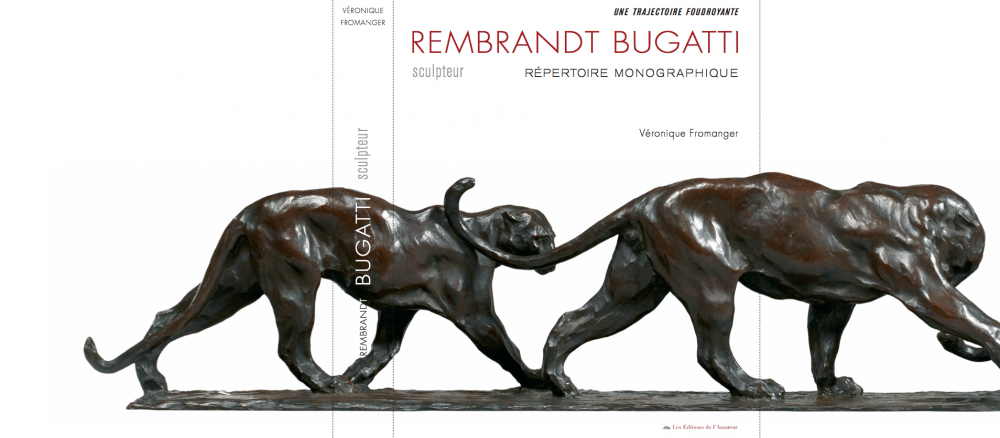
REMBRANDT BUGATTI-Répertoire monographique- PLAN DU LIVRE

Toute une vie avec Bugatti: Alain Delon 1935-2024: en 2016 la journaliste Valérie du Figaro lui demande : "vous auriez aimé le rencontrer?" Alain Delon lui répond avec émotion en retenant son souffle: "ouf....j'aurais été son objet, son serviteur, saurait été formidable il y a tout chez Bugatti, toute la vie, tous les sentiments sont dans ses oeuvres, j'ai envie de les embrasser comme un fou" A whole life with Bugatti: Alain Delon 1935-2024: in 2016 the journalist Valérie from Le Figaro asked him: "would you have liked to meet him?" Alain Delon answered her with emotion, holding his breath: "phew....I would have been his object, his servant, it would have been great there is everything in Bugatti, all life, all feelings are in his works, I want to kiss them like crazy"
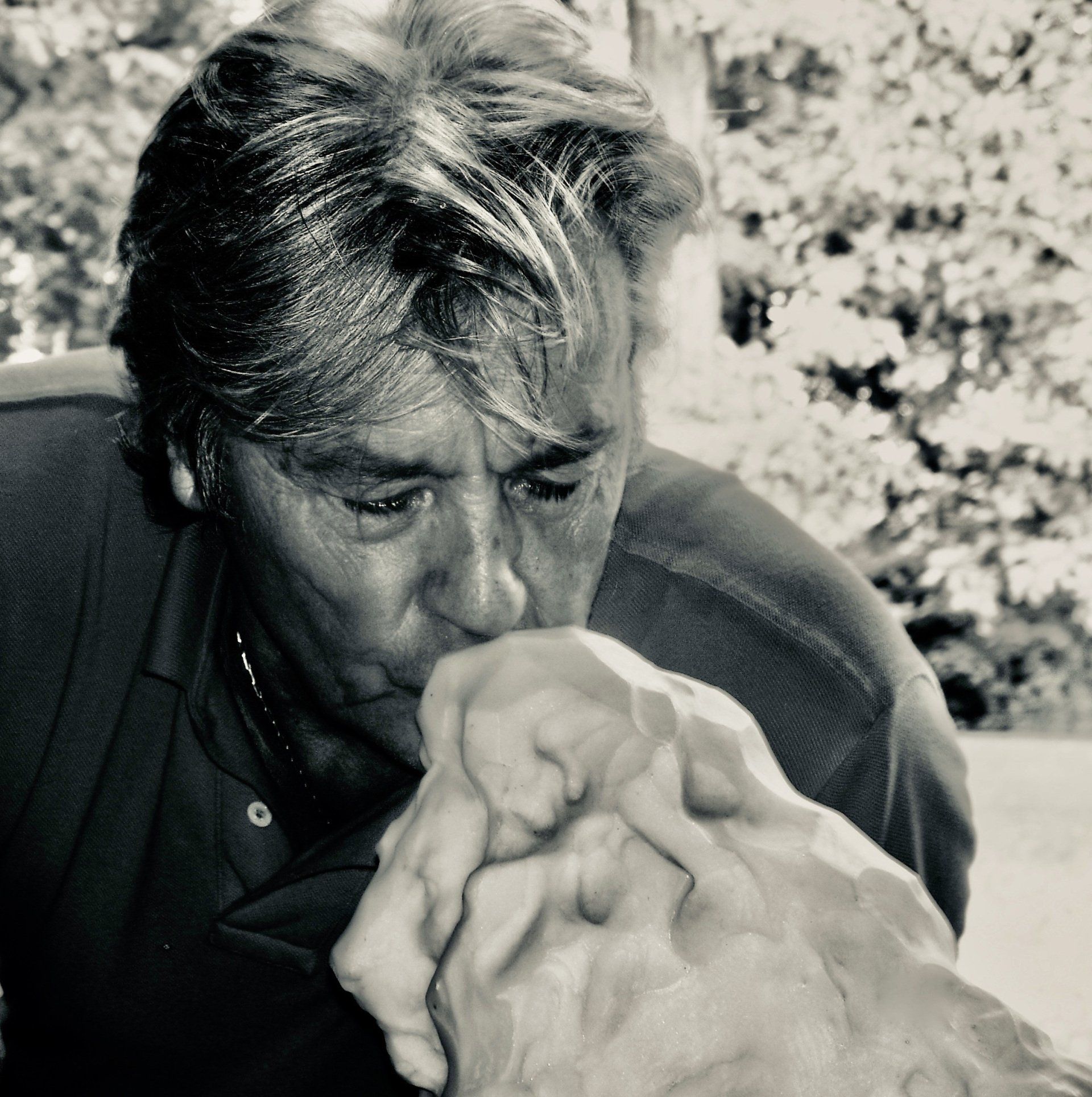
De 1979 à 2024, la collection Alain Delon. Que peut-on dire d'un homme comme lui? Dans le monde entier Alain Delon est une icône, déjà une légende, une image étincelante, charnelle, sauvage.Mais, derrière les mots et les images, il n'y a plus qu'un artiste solitaire dont la sensibilité à fleur de peau est extrême. Collectionner les oeuvres d'art fut toujours pour lui un mode d'expression vital.Sa rencontre avec Rembrandt Bugatti était inévitable. From 1979 to 2024, the Alain Delon collection. What can we say about this man? Worldwide Alain Delon is an icon, already a legend, a sparkling, carnal, wild image. But behind the words and the images there is only one solitary man, an artist whose sensitivity is extreme. Collecting works of art is for him a vital mode of expression. His meeting with Rembrandt Bugatti was inevitable.
